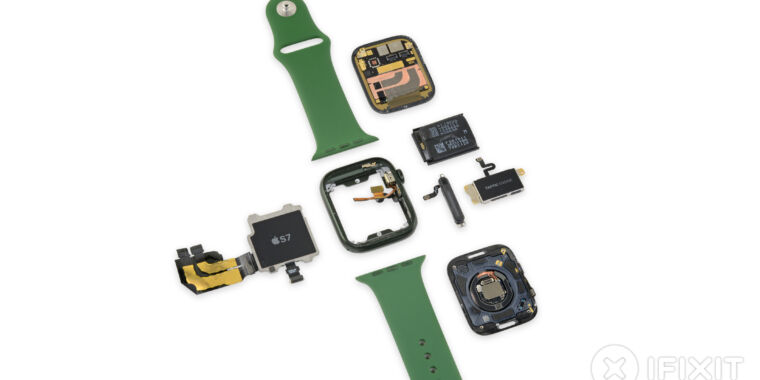
-
iFixit’s full Apple Watch Series 7 teardown.
-
iFixit notes that the “fiddly bracket” near the service port in the Series 6 (right) is missing from the Series 7 (left).
-
The back of the display in the Series 7 (left) and Series 6 (right).
As has become something of a ritual, tools-seller and repair-advocacy group iFixit has published a detailed teardown of the latest Apple product. This time, we get a look at the innards of the Apple Watch Series 7.
This Watch model was announced in September—but without a release date. The eventual ship date for the first orders was Friday, October 15.
iFixit’s teardown lends credence to one of the prevailing theories about why there was a delay. The Apple Watch Series 7 appears to use an on-cell touch OLED panel, the same type seen in the iPhone 13 line. Consulting with a former Apple engineer, iFixit suggests that supply challenges related to this display tech are likely the reason the Apple Watch launched a bit late this year and why the device didn’t get a release date in last month’s keynote announcing it.
As for other findings, the diagnostic port is gone. iFixit speculates that Apple now uses a wireless interface to service the Watch and reasonably ventures a guess that this may be a test drive for the eventual removal of the iPhone’s lone port.
The new Watch also has a slightly bigger battery than its predecessor. Whereas the 40 mm Series 6 had a 1.024 Wh battery, the 41 mm Series 7 comes in at 1.094 Wh. The 44 mm Series 6’s battery was 1.17 Wh, and the 45 mm Series 7’s is 1.189 Wh. It’s not a dramatic difference, but it likely plays a role in keeping the new Watch’s rated battery life the same as the 2020 model, despite the larger, more power-hungry screen.
Of course, iFixit’s teardowns are as much about assessing the serviceability of a device as they are about geeking out about hardware changes.
To that end, iFixit gave the Watch a 6 out of 10 repairability score, citing its “modular construction” and “straightforward access to the screen and battery.” Knocks against the Watch include the absence of a service manual and the fact that the screen must be unglued and reglued with every repair.
Listing image by iFixit
https://arstechnica.com/?p=1806823

